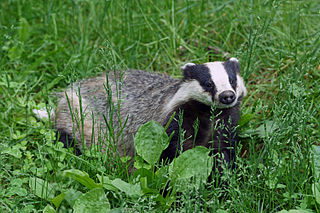Related Research Articles

Badgers are short-legged omnivores in the family Mustelidae. Badgers are a polyphyletic rather than a natural taxonomic grouping, being united by their squat bodies and adaptions for fossorial activity. All belong to the caniform suborder of carnivoran mammals.

The honey badger, also known as the ratel, is a mammal widely distributed in Africa, Southwest Asia, and the Indian subcontinent. Because of its wide range and occurrence in a variety of habitats, it is listed as Least Concern on the IUCN Red List.

The European badger, also known as the Eurasian badger, is a badger species in the family Mustelidae native to Europe and West Asia and parts of Central Asia. It is classified as least concern on the IUCN Red List, as it has a wide range and a large, stable population size which is thought to be increasing in some regions. Several subspecies are recognized, with the nominate subspecies predominating in most of Europe. In Europe, where no other badger species commonly occurs, it is generally just called the "badger".

The European hedgehog, also known as the West European hedgehog or common hedgehog, is a hedgehog species native to Europe from Iberia and Italy northwards into Scandinavia and westwards into the British Isles. It is a generally common and widely distributed species that can survive across a wide range of habitat types. It is a well-known species, and a favourite in European gardens, both for its endearing appearance and its preference for eating a range of garden pests. While populations are currently stable across much of its range, it is declining severely in Great Britain where it is now Red Listed, meaning that it is considered to be at risk of local extinction. Outside its native range, the species was introduced to New Zealand during the late nineteenth and early twentieth centuries.

Meles is a genus of badgers containing four living species known as Eurasian badgers, the Japanese badger, Asian badger, Caucasian badger and European badger. In an older categorization, they were seen as a single species with three subspecies. There are also several extinct members of the genus. They are members of the subfamily Melinae of the weasel family, Mustelidae.

The American badger is a North American badger similar in appearance to the European badger, although not closely related. It is found in the western, central, and northeastern United States, northern Mexico, and south-central Canada to certain areas of southwestern British Columbia.

Rodney Stoke is a 69.6 hectare biological Site of Special Scientific Interest, just north of the village of Rodney Stoke in the Mendip Hills, Somerset, notified in 1957.

Babcary Meadows is a 13.6 hectares biological Site of Special Scientific Interest north of Babcary in Somerset, notified in 1988.
Margaric acid, or heptadecanoic acid, is a saturated fatty acid. Its molecular formula is CH3(CH2)15CO2H. Classified as an odd-chain fatty acid, it occurs as a trace component of the fat and milkfat of ruminants. Salts and esters of margaric acid are called heptadecanoates.

The northern white-breasted hedgehog is a species of hedgehog native to Eurasia.

The Asian badger, also known as the sand badger, is a species of badger native to Mongolia, China, Kazakhstan, Kyrgyzstan, the Korean Peninsula and Russia.

The Japanese badger is a species of carnivoran of the family Mustelidae, the weasels and their kin. Endemic to Japan, it is found on Honshu, Kyushu, Shikoku, and Shōdoshima. It shares the genus Meles with its close relatives, the European and Asian badgers. In Japan, it is called by the name anaguma (穴熊) meaning "hole-bear", or mujina.

Trypanosoma lewisi is a globally distributed parasite of Rattus species and other rodents such as mice, and of kangaroo rats in America. Among these host species were two endemic species of rats: Rattus macleari and Rattus nativitatis. Both are now believed to be extinct. It is not very clear whether or not the same parasite infected both species. However, both parasites are very similar. The northern rat flea acts as the vector for the parasite, harboring the epimastigote stage in its midgut. The trypomastigote is the stage that is present in the main host, the rodent. The epimastigote form attaches itself to the rectum of the insect using its flagella to burrow through the rectal walls. The parasites also appear in the flea's feces. Ingestion of either the flea or its feces during grooming infects the host rodent with the parasites. T. lewisi is normally non-pathogenic but is known to have produced fatal infections in rats.
Trypanosoma irwini is a blood parasite of koalas. First discovered in 2009 by Linda M. McInnes and her peers, it was named in honor of Steve Irwin, "The Crocodile Hunter". The study done by McInnes et al. was the first to describe a Trypanosoma species from koalas.
Paraceras melis, the badger flea, is an external parasite of the European badger. It has also been found on the fox, the dog, the cat, the European polecat, the mole and the fallow deer.

The Caucasian badger or Southwest Asian badger is a species of badger native to Western Asia and some islands in the Mediterranean Sea.

Hog badgers are three species of mustelid in the genus Arctonyx. They represent one of the two genera in the subfamily Melinae, alongside the true badgers.
References
- ↑ "Species Trypanosoma pestanai". UniProt . Retrieved 7 July 2013.
- ↑ Regina Lizundia; Chris Newman; Christina D. Buesching; Daniel Ngugi; Damer Blake; Yung Wa Sin; David W. Macdonald; Alan Wilson; Declan McKeever (February 14, 2011). "Evidence for a Role of the Host-Specific Flea (Paraceras melis) in the Transmission of Trypanosoma (Megatrypanum) pestanai to the European Badger". PLOS ONE . 6 (2): e16977. Bibcode:2011PLoSO...616977L. doi: 10.1371/journal.pone.0016977 . PMC 3038870 . PMID 21340028.